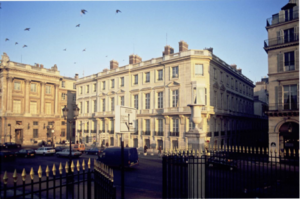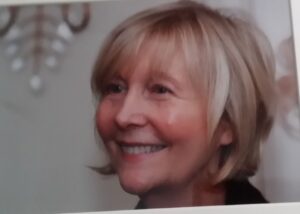by Renee M Earle
In 2022, Europe and the U.S. marked the 75th anniversary of the Marshall Plan, and this year is the 20th anniversary of a permanent Paris exhibit that documents its achievements. When I was posted to Paris as the Public Affairs Officer from 2002 to 2006, the public affairs offices (except for the press section), along with the consular affairs services, were in the Hôtel de Talleyrand facing the Place de la Concorde, about a block from the main U.S. embassy building. The Talleyrand, as we called it, gave visitors easier access for these more public functions of the embassy. Running back and forth to meetings at the embassy was a small price to pay for offices overlooking the majestic Concorde.
In 2003, the Talleyrand marked a new milestone. Following initial restorations of the Talleyrand’s State Apartment rooms, the embassy invited representatives of the Marshall Plan’s participating nations and restoration sponsors to celebrate the opening of the George C. Marshall Center and its permanent exhibit, “The Marshall Plan: The Vision of a Family of Nations,” created by French and American historians and curators to memorialize the project that revitalized Europe after the devastation of World War II.
The Talleyrand has an illustrious history dating from the 18th century and a no-less- illustrious list of inhabitants that included the building’s namesake today, Charles-Maurice de Talleyrand-Périgord, and the Rothschild family, who made the Talleyrand their home until the German occupation of Paris. The “hôtel particulier” (private urban mansion) lived through an evolving history of changes, including its own salvation when only quick action by the Allied forces saved the Place de la Concorde and surrounding buildings from Hitler’s order to destroy Paris.

The U.S. government began renting the building after WWII in 1948 and purchased it in 1950. During those years, its rooms housed the U.S. Economic Cooperation Administration, led by Ambassador Averill Harriman, and soon thereafter the representatives of the sixteen European countries who came together to plan and administer the European Recovery Program under what had already become known as the “Marshall Plan.” Noteworthy at the time is that the plan also included Germany. The USSR was the original seventeenth member but since “glasnost” was not the order of the day in the time of Josef Stalin, the USSR decided that the project’s conditions of transparency were not to its liking and, amid fear that the project would open its sphere of control to Western influence, the USSR abandoned the project. One can only imagine what the recent history of Eastern and Central Europe, including Russia, would have been had the Marshall Plan extended to these countries.
There was opposition in the U.S. to supporting any plan of European recovery, and many called for balancing the U.S. budget instead, an argument that reverberates today. Then Secretary of State George C Marshall returned from a conference of foreign ministers in Moscow in 1947 and reported his findings to Americans in a radio address, describing the dire state of the European economy which urgently needed help. “The patient is dying,” he said, “while doctors deliberate.” Marshall had also insisted that it was for the Europeans to design and implement the program with U.S. collaboration.
Despite the opposition, in April of 1948, Congress approved the European plan submitted and passed the European Assistance Act. Work in Paris now began in earnest on the details of how the aid from the U.S. was to be divided, decisions the Europeans had to make among themselves. It was a daunting task of international cooperation. Sixteen nations plus delegates from the occupied zones of West Germany created the Organization of European Economic Cooperation (OEEC) and began their deliberations.

The George C Marshall Center’s permanent exhibit documents this complex and demanding enterprise with archival photographs and artifacts showing how goods and products began to move again, bolstering the economies of both the sending and receiving countries. For example, the exhibit recalls that Austria was once again able to obtain Merino wool from Italy and a pencil factory in Germany again acquired the necessary cedar from California. The display also recalls ingenious solutions to difficult problems such as the “double duty dollars” that would allow countries whose currency was not strong enough to use Marshall Plan dollar grants.

Europeans had begun their own work of recovery separate from the Marshall Plan, and the American economy was certainly enriched by a recovered European economy, but together the U.S. and Europe achieved a revitalization that proved of mutual long-term benefit. Already in 1959, the U.S., Germany, Great Britain, and France announced that it was time for European countries to help less developed countries, and the Organization for Economic Cooperation and Development replaced the OEEC.
Working to remind the French people of our shared values following the U.S. invasion of Iraq in 2003, the public affairs section drew daily inspiration from this historical panorama of European and U.S. joint effort. We were heartbroken when we were told that planning for all embassy offices to be relocated into the main embassy building was to begin. Security concerns heightened after Sept.11, 2001, and credible threats to U.S. interests in Paris dictated the move to the embassy building, which afforded the required setback with concrete barriers from the street and other security protections that the Talleyrand building could not provide.
It consoled us to know that our office space would be included in the building’s monumental restoration and that the George C. Marshall Center would remain an integral part of the Hôtel de Talleyrand. Although now open to the public only one day a year during the European days of cultural heritage and for special tours, the center still hosts international exchange activities. The American law firm Jones Day, which leases part of the building and contributed to the building’s restoration, and the Department of State remain the custodians of this unique example of joint French and American cultural heritage.![]()
For those who wish to delve deeper into the architectural and historical evolution of this magnificent “hôtel particulier,” from its creation in the middle of the 18th century to its recent meticulous restoration, I recommend the commemorative book published through the University of Florida’s Publications Office, Concorde: Hôtel de Talleyrand, George C. Marshall Center, a treasure-trove of information and images. My thanks also to Candice Nancel, Cultural Heritage Manager at the U.S. Embassy in Paris, for her assistance.

Renee M. Earle is a retired Public Diplomacy Foreign Service with the rank of Minister-Counselor. She served at embassies in Turkey, USSR/Russia, Kazakhstan, the Czech Republic, France, and the U.S. Mission to the European Union in Brussels. Domestic positions with the Department of State included Diplomat-in-Residence at Duke University in North Carolina, Acting Office Director of Public Diplomacy in the European Bureau, and Chief of the Central Asia Division of the Voice of America, where she directed the Pashto, Dari, Farsi, Uzbek, Azeri, and Turkish language services. She currently serves as the Publisher of the American Diplomacy Journal.
